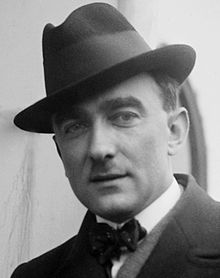Piano Sonata No. 2 (Szymanowski)
| Piano Sonata No. 2 | |
|---|---|
 | |
| Key | A Major |
| Catalogue | M25 |
| Opus | Op.21 |
| Form | Piano sonata |
| Composed | 1910-1911 |
| Dedication | Madame Nathalie Davidoff |
| Published | 1912 |
| Publisher | Universal Edition |
| Duration | About 25-28 minutes |
| Movements | 2 |
| Premiere | |
| Date | 7th May 1911 |
| Location | Warsaw, Poland |
| Performers | Arthur Rubinstein |
Karol Szymanowski's Piano Sonata No. 2 in A major, Op. 21, M25, is a piano sonata in two movements. It was completed in 1911 and published in 1912 by Universal Edition Vienna. The sonata is representative of the start of Szymanowski's late style. It was premiered by Arthur Rubinstein on 7th May 1911.[1][2]
Historical background
The work was completed in Tymoszówka, when Szymanowski was 29 years old.
Shortly after its completion, Szymanowski wrote in a letter to Polish friend and music historian Zdzisław Jachimecki:
"I have just finished the second 'Piano Sonata' before Arthur arrived. At first I did not attach a great importance to it, yet after a detailed study and after Arthur having played it all the 'hidden virtues' have come to light and as a result Ficio and Arthur got immensely excited about it, almost considering it superior to the Symphony."[3]
Analysis
The sonata comprises two movements:
- Allegro assai (Molto appassionato) (A Minor - D♭ Major - A Minor - A Major)
- Theme and variations (A Major - F Major - B♭ Major - A Major - E Major - A Major)
1. Allegro assai (Molto appassionato)

8 - 10 minutes
The first movement starts in cut time. It opens with a dark, chaotic and almost atonal introductory theme, which is referred to at various stages throughout the two movements, of broken octaves descending chromatically in tuplets in the left hand, aided by a simple melody of ascending octaves in the right. The theme progresses and changes time signatures numerous times until the start of the Quasi andante section
At the start of the Quasi andante section, the key changes to D♭ Major and 2/4 time, and a new theme emerges. This time, the theme is less chaotic and more melodic and lyrical.
2. Theme and variations
17 - 19 minutes
The second movement comprises a theme, eight variations and a fugue.
Reception
After a performance of the sonata at a concert devoted to Szymanowski's works in December 1911, Willy Renz wrote in the magazine Die Musik:
“If the composer forces himself towards greater transparency, to a sensible limit and concentration, if he can restrain his excessive fondness for contrapuntal tricks, polyphonic complications and orchestral excesses, we will have high hopes of him”[4]
References
- ^ "Piano Sonata No. 2 A major op. 21 (1910-1911) | Karol Szymanowski". www.karolszymanowski.pl. Retrieved 2018-08-07.
- ^ "Piano Sonata No. 2 in A major Op. 21 – Karol Szymanowski". Culture.pl. Retrieved 2018-08-12.
- ^ https://culture.pl/en/work/piano-sonata-no-2-in-a-major-op-21-karol-szymanowski
- ^ "Piano Sonata No. 2 A major op. 21 (1910-1911) | Karol Szymanowski". www.karolszymanowski.pl. Retrieved 2018-08-07.
